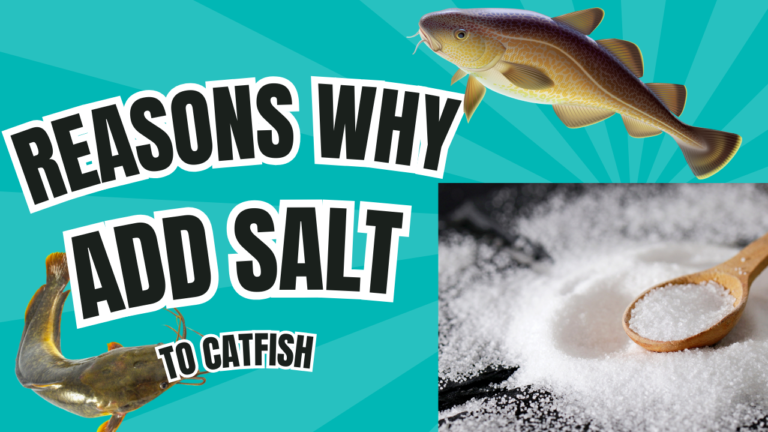Reasons you should add salt to harvested catfish is a must-know as a fish farmer or lover. Whether you’re preparing catfish for consumption or for preservation, adding salt to harvested catfish offers numerous advantages. From enhancing flavor to improving the preservation process, salt plays a pivotal role in ensuring your catfish is processed in the best way possible.
In this blog post, we’ll explore the reasons you should add salt to harvested catfish, explain its multiple benefits, and discuss the limitations associated with it. Whether you’re a seasoned farmer or just getting started, understanding these points will make your catfish processing experience more efficient and successful.
Why Add Salt to Harvested Catfish?
The addition of salt to harvested catfish may seem like a basic step, but it’s critical for multiple reasons. Salt can kill, clean, and preserve catfish, making the entire post-harvest process easier. Here are the main reasons you should add salt to harvested catfish:
1. To Humanely Kill the Catfish
Catfish are highly resilient creatures that can survive out of water for several hours, sometimes up to 12 hours. This ability makes it challenging for farmers to prepare them for smoking, consumption, or other forms of processing. When catfish are still alive, they may thrash around vigorously, making the handling process difficult and potentially dangerous.
One of the main reasons you should add salt to harvested catfish is that it acts as a humane method for killing them. By sprinkling salt over the fish in a container, catfish react to the salt by becoming more vigorous initially, but eventually succumbing after about 30-50 minutes. This process allows you to work with the fish without the struggle of handling a live and thrashing animal.
Additionally, by killing the fish quickly, you also reduce the post-harvest stress that the catfish experiences, which can lead to better-quality meat. Prolonged stress can degrade the quality of the fish meat, so immediate processing with the help of salt ensures a better final product.
2. Improves the Taste of Catfish
Another reason you should add salt to harvested catfish is to enhance its flavor. Salt is a well-known flavor enhancer for various types of food, and catfish is no exception. Adding salt before smoking or cooking can make the fish taste better and more savory. Salt penetrates the flesh of the catfish, giving it a mild, briny taste that elevates its natural flavor profile.
This is especially important for catfish that will be smoked or dried, as the salt acts not just as a flavoring agent but also as a preservative, improving the taste and making it more enjoyable for consumers.
3. Removes Slime and Mud
Catfish are notorious for their slimy texture, which is often the result of a mucous layer on their skin. This slime can make them difficult to handle and unpleasant to prepare for cooking or smoking. One of the best ways to remove this slimy layer is by adding salt to the harvested fish.
Salt works by breaking down the slime, making it easier to wash away. After you add salt to the fish and allow them to sit for 30 to 50 minutes, you’ll notice that the water becomes thick and slimy when you rinse them.
You may need to wash the fish several times with fresh water to fully remove the slime. After about two or three rounds of washing, the catfish will be much cleaner and easier to work with.
4. Preservation of Catfish
Salt has long been used as a natural preservative, and it’s no different when it comes to preserving catfish. Salt helps to draw out moisture from the fish through a process called osmosis. By reducing the water content in the fish, salt prevents the growth of bacteria and other microorganisms that cause spoilage.
This dehydration process is key for anyone who intends to smoke or dry their catfish for long-term storage. Not only does salt preserve the fish, but it also helps to firm up the flesh, improving its texture over time. For farmers or processors looking to extend the shelf life of their catfish, salt is an essential ingredient.
5. Improves Texture and Firmness
Another great reason you should add salt to harvested catfish is that it improves the texture of the fish. When salt is applied, it firms up the flesh of the fish by removing excess moisture. This is particularly important for those who plan to smoke or dry the fish. Firm fish holds its shape better during the smoking or drying process and also provides a better mouthfeel for consumers.
Moreover, firm fish is easier to cut and handle, reducing the risk of damage during processing. The result is a higher-quality, better-tasting product that is easier to store and prepare later.
Limitations of Adding Salt to Harvested Catfish
While the benefits of adding salt to harvested catfish are numerous, there are also some limitations and potential drawbacks to be aware of. Overusing salt or misapplying it can lead to a few issues:
1. Over-salting Can Affect Flavor
One potential downside of adding salt to catfish is the risk of over-salting the meat. While salt improves the flavor, adding too much can result in overly salty fish, which may not be palatable for everyone, particularly those on low-sodium diets. To avoid this, it’s important to use just enough salt to get the benefits without compromising the taste.
2. Impact on Environmental Ecosystems
Large-scale commercial fish farms must also consider the environmental impact of using salt. The runoff from farms that use salt for processing can increase the salinity of nearby water bodies, potentially disrupting the local ecosystem. This is especially a concern for farms located near rivers or coastal areas. Sustainable farming practices should be employed to minimize this risk.
3. Loss of Nutrients
Excessive salting can also dehydrate the fish to the point where some vitamins and minerals are lost. While salt preserves and firms the fish, it can also reduce the overall nutritional content if used in excess. Balance is key—use just enough salt to get the benefits without sacrificing nutritional value.
Conclusion
In summary, the reasons you should add salt to harvested catfish are plentiful. From killing the fish humanely to improving flavor, removing slime, preserving the fish, and enhancing texture, salt plays a vital role in the post-harvest processing of catfish.
However, it’s important to be mindful of the limitations, such as over-salting, environmental concerns, and nutrient loss.
By using salt appropriately, you can ensure that your harvested catfish are prepared efficiently, taste great, and are preserved for longer-term storage.
Whether you are processing fish for personal use or as part of a larger farming operation, understanding how and why to use salt will make a significant difference in your overall results.
Also, read the post Comprehensive Guide to Fish Farming: From Setup To Harvest





